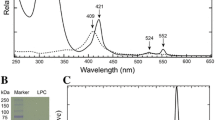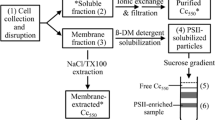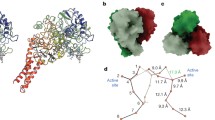Abstract
In addition to several cytochromes three iron sulfur proteins were detected in mixotrophically grown cells of Ectothiorhodospira shaposhnikovii, a member of the Chromatiaceae. They were identified as a bacterial ferredoxin and two high potential iron sulfur proteins (HIPIPs). The two HIPIPs were purified and characterized. They were named according to their differing retention times on a DEAE-cellulose column using a continuous NaCl gradient: “early” and “late” HIPIP. The HIPIPs contain 4 mol of non-heme iron and 4 mol of acid labile sulfur per mol protein. Under the conditions of purification the “early” HIPIP (E m, 7+270 mV) was present in a semi-reduced state. Using ion-exchange chromatography the “early” HIPIP could be split into a reduced green-brown (pI=3.7) and an oxidized red-brown (pI=3.9) fraction. The “late” HIPIP (pI=3.8) showed a midpoint potential of only+155 mV, the lowest redox potential of a HIPIP described so far.
Similar content being viewed by others
Abbreviations
- HIPIP:
-
high potential iron sulfur protein
- MOPS:
-
3(N-morpholino)propane sulfonate
- SDS:
-
sodium dodecylsulfate
References
Bartsch RG (1963) Nonheme iron proteins and Chromatium iron protein. In: Gest H, San Pietro A, Vernon LP (eds) Bacterial photosynthesis. The Antioch Press, Yellow Springs, Ohio, pp 315–326
Bartsch RG (1978) Purification of (4Fe-4S)1-2-ferredoxins (high potential iron sulfur proteins) from bacteria. In: Collowick SP, Kaplan, NO (eds) Methods in enzymology, vol 53. Academic Press, New York, pp 329–340
Dus K, Klerk H de, Sletten K, Bartsch RG (1967) Chemical characterization of high potential iron sulfur proteins of Chromatium and Rhodopseudomonas gelatinosa. Biochim Biophys Acta 140:291–311
Fischer U (1980) A high potential iron sulfur protein of the purple sulfur bacterium Thiocapsa roseopersicina. Z Naturforsch 35c:150–153
Fukumori Y, Yamanaka T (1979) A high potential nonheme iron protein (HiPIP)-linked, thiosulfate-oxidizing enzyme derived from Chromatium vinosum. Curr Microbiol 3:117–120
Imhoff JF, Trüper HG (1977) Ectothiorhodospira halochloris sp. nov., a new extremely halophilic phototrophic bacterium containing bacteriochlorophyll b. Arch Microbiol 114: 115–121
Klerk H de, Kamen MD (1966) A high potential non-haem iron protein from the facultative photoheterotroph Rhodopseudomonas gelatinosa. Biochim Biophys Acta 112:175–178
Lowry OH, Rosebrough NJ, Farr AL, Randall RJ (1951) Protein measurement with the Folin phenol reagent J Biol Chem 193:265–275
Meyer TE, Sharp JJ, Bartsch RG (1971) Isolation and properties of rubredoxin from the photosynthetic green sulphur bacteria. Biochim Biophys Acta 234:266–269
Meyer TE, Kennel SJ, Tedro SM, Kamen MD (1973) Iron protein content of Thiocapsa pfennigii, a purple sulfur bacterium of atypical chlorophyll composition. Biochim Biophys Acta 292:634–643
Orme-Johnson WH, Orme-Johnson NR (1978) Overview of iron sulfur proteins. In: Collowick SP, Kaplan NO (eds) Methods in enzymology, vol 53. Academic Press, New York, pp 259–268
Rabinowitz JC (1978) Analysis of acid labile sulfide and sulfhydryl groups. In: Collowick SP, Kaplan NO (eds) Methods in enzymology, vol 53. Academic Press, New York, pp 275–277
Ruzicka FJ, Beinert H (1978) The soluble “high potential” type ironsulfur protein from mitochondria is aconitase. J Biol Chem 253:2514–2517
Steinmetz MA, Fischer U (1982) Cytochromes of the green sulfur bacterium Chlorobium vibrioforme f. thiosulfatophilum. Purification, characterization and sulfur metabolism. Arch Microbiol 131:19–26
Steinmetz MA, Trüper HG, Fischer U (1983) Cytochrome c-555 and iron-sulfur protein of the non-thiosulfate-utilizing green sulfur bacterium Chlorobium vibrioforme. Arch Microbiol 135: 186–190
Tedro SM, Meyer TE, Kamen MD (1977) Primary structure of a high potential iron sulfur protein from a moderately halophilic denitrifying coccus. J Biol Chem 252:7826–7833
Tedro SM, Meyer TE, Kamen MD (1979) Primary structure of a high potential, four iron sulfur ferredoxin from the photosynthetic bacterium Rhodospirillum tenue. J Biol Chem 254:1495–1500
Weber K, Osborne M (1969) The reliability of molecular weight determinations by dodecylsulfate-polyacrylamide-gel-electrophoresis. J Biol Chem 244:4406–4412
Wermter U, Fischer U (1983) Molecular properties of a high potential iron sulfur protein of Chromatium warmingii. Z Naturforsch 38c:968–971
Yoch DC, Valentine RC (1972) Ferredoxins and flavodoxins of bacteria. In: Clifton CE, Raffel S, Starr MP (eds) Annual review of microbiology, vol 26. Annual Reviews Inc, Palo Alto, California, USA, pp 139–162
Author information
Authors and Affiliations
Rights and permissions
About this article
Cite this article
Kusche, W.H., Trüper, H.G. Iron sulfur proteins of the purple sulfur bacterium Ectothiorhodospira shaposhnikovii . Arch. Microbiol. 137, 266–271 (1984). https://doi.org/10.1007/BF00414556
Received:
Accepted:
Issue Date:
DOI: https://doi.org/10.1007/BF00414556




